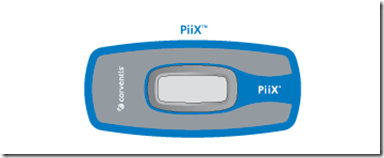It sounds as if the patch has networking already configured, so whenever a signal is received via a participating wireless carrier, you and the patch are connected. The device is FDA approved. You have to wear this on your chest and it is water resistant, so I am assuming you can go in the shower, but maybe not swim with it? I wished they would have made it skin tone, or at least maybe provide some skins down the road as this is a big blue thing hanging on your chest.
The technology is to report fluid levels and trials are being considered to also see if it can predict sleep apnea. There is also another patch in investigations at the FDA that could report back heart rhythms, which could server to help predict heart attacks. Part of the focus here is to reduce hospitalization incidents according to the website. At the rate we are going, perhaps we will have a mobile hospital on wheels some day to keep admissions out of the main building (grin). I didn’t see where one could put the unit on “do not disturb” other than to move out of an area where wireless service would not be available.
As usual with most of these types of medical devices, your clinician is notified with an alert, and the detection process is through the use of proprietary algorithms. The 2 hottest trends in healthcare are still algorithms and whistleblowers. There’s also a similar device from Medtronic that is implanted under the skins, so device or patch is choice it appears. BD
Sensor patch: This 15-centimeter wearable patch measures temperature, heart and respiration rates, levels of physical activity, body position, and body-fluid levels using sensors that include an accelerometer and an impedance monitor.

- Patient-Friendly Collection of Clinical Information
The unobtrusive design of the PiiX, its ability to automatically detect clinical events and the wireless transmission of data all unite to enable a more favorable patient experience. By minimizing the number of steps needed to comply, information can be collected and potential events can be identified more reliably, while a patient goes about their daily routine.
- Exception-based Notification of Clinical Events
Using proprietary algorithms, PiiX collects an ECG waveform upon detection of an abnormal heart rate and wirelessly transmits the event information to our secure server, without requiring patient interaction. Clinicians are then notified of detected clinical events using their own pre-set notification criteria.
- Longitudinal Physiological Trends
Once activated, PiiX will begin automatically collecting physiological data for transmission to Corventis. The data are used to create longitudinal trends of Heart Rate, Heart Rate Variability, Respiration Rate, Fluid Status and Activity, which a clinician may then use to evaluate a patient’s health status and create personalized clinical decisions.
- Global Use and Access
Through partnerships with wireless providers across the globe, our solutions can be used across geographies – whether a patient is around the corner, or around the globe. In addition, information is available through our website 24 hours a day, seven days a week, allowing clinicians to determine when, where and how to manage their patients.
A 15-centimeter wireless sensor, recently approved by the FDA, holds the promise of reducing hospitalizations by allowing automated early detection of heart failure. The noninvasive device, which costs a few hundred dollars and adheres to a patient's chest, monitors indicators of heart health--including heart and respiration rates, levels of patient activity, and even the accumulation of body fluid--as patients go about their daily lives.
Part of a technology platform now being marketed by Corventis, a startup in San Jose, CA, the waterproof sensor beams data to a special cell-phone-like gadget in the patient's pocket or home. From there, the data is wirelessly transmitted to the company's servers. Algorithms detect anomalies and transmit data to physicians via the Web or a mobile device, drawing attention to patients who need immediate care.
"We've never had that before for remote monitoring," Topol says. Beyond warning of heart failure through fluid detection, the device includes an accelerometer that tells if a person is generally less active--a sign that he is in distress--or not lying flat at night, which is another proxy measurement for fluid buildup in the lungs. (Lying flat makes the resulting shortness of breath worse, and sufferers will often sleep propped up on pillows.)
Technology Review: Remote Monitoring of the Heart




0 comments :
Post a Comment